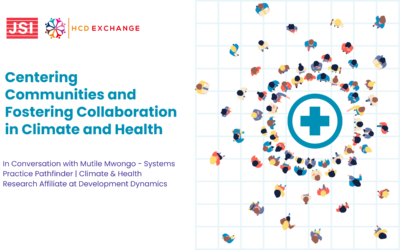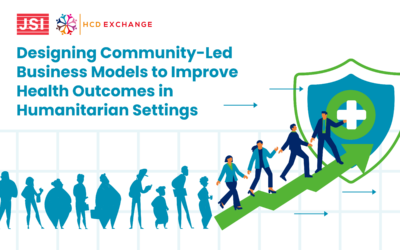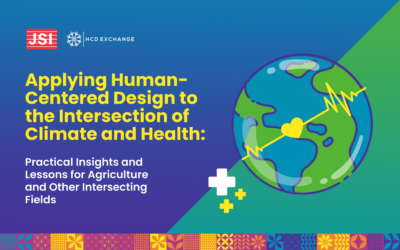The following remarks were delivered as the opening plenary of the HCDExchange International Youth Day on August 12, 2020. The transcript is reproduced here for the benefit of our community.
Opening plenary speakers
- Priyambada Seal, Advocacy and Partnerships Co-ordinator / Restless Development India
- Jude Njikem, Co-ordinator SONKE Gender Justice / MenEngage Africa
- Daniel Zuga, Youth Accountability Advocate / Restless Development Tanzania
- Annah Sango, Country Lead / Y+ Zimbabwe
Priyambada Seal, Advocacy and Partnerships Co-ordinator / Restless Development India
Dear global community,
The pandemic has changed our world. It’s changed mine. My name is Priyambada. I work for Restless Development, a global youth organization working with young people on SRHR in India. I serve as the Advocacy and Partnerships Co-ordinator. In the new normal that we live in, adolescents and young people in India are facing challenges on the basic ability to take care of their bodily autonomy and sexual health. The impact of the pandemic has further hit young women and girls disproportionately. Not just bio medically, but in terms of a systematic de-prioritization and re-allocation of funds away from the issues that mostly shape their lives (including mine). One of these key issues is sexual and reproductive health which we as a global community must consider as an essential service if we truly believe in the FP2020 and Global Goals commitments.
The unavailability of contraceptives has affected young people’s right to plan if and when to have children as evident from the rampant rise in unplanned teen pregnancies across the globe. We cannot let this pandemic endanger fundamental choices like pregnancy and access to safe maternal care.
The pandemic-induced lockdowns further magnify the very real possibility of being in quarantine with abusers, while taboos around IPV and abuse within families become harder to tackle. Although data on gender based violence is difficult to collect, with only 40% of women seeking help of any kind after such abuse occurs and only 10% willing to approach the police for help, yet even conservative estimates have shown a dramatic rise in GBV all over the world. When we have conversations about “building back better” in a post-pandemic world, it must acknowledge how most of our country’s economic labor is dependent on the backs of these young women and girls who often are tasked with unpaid care work that goes into maintaining life as we know it.
Having said that, young people are responding to the challenges by reaching out and responding to situations more than ever. Meaningful engagement of young people, especially young women and girls for the reasons listed above, is the only way to address key issues that concern them. We must channel youth-powered design, an approach rooted in empathy and contextualization of individual experiences, to center women’s and girls’ voices, make them agents that can decide and design a better world post-pandemic.
Jude Njikem, Co-ordinator SONKE Gender Justice / MenEngage Africa
One. Two. [Counting.] Yes, just two seconds. Every two seconds, a girl is married before she is physically or emotionally mature enough to become a wife or a mother, according to a report by Girls Not Bride. My name is Jude. I’m from Cameroon and I work with MenEngage Africa as the Youth Coordinator. In Cameroon, 31% of girls are married before their 18th birthday and 10% are married before the age of 15. The Covid-19 pandemic worsens our plight. Schools have shut down and many adolescent girls are more likely to be given away in marriage in these times.
Human centered design further puts people at the core of designing programs. The idea is to truly meet the needs of the beneficiaries, and not merely problem solving. Addressing child marriage and the complications that come with it such as teen and unintended pregnancies, obstetric fistula, and poverty require that we employ a youth powered approach in designing programs to reach both in and out of school girls. We must provide adolescent girls with information that will help them make the right decisions and stand for their rights. We must work with men and boys who will take the lead in advocating against this harmful traditional practice. At MenEngage Africa, we recruit, train and deploy young men to fifteen countries in Africa, including Cameroon to strengthen the fight against gender inequality through gender transformative and youth centric approaches.
There is so much more to be done, and young people are poised for action and must be at the center of programs to address child marriage and every other challenge that affects adolescents.
Daniel Zuga, Youth Accountability Advocate / Restless Development Tanzania
My name is Daniel Zuga, a passionate SRHR youth advocate with Restless Development Tanzania and for most of my life, family discussions around SRHR have been deemed to be a taboo. This obstacle which is faced by many of my peers has limited our accessibility to information on our sexual reproductive health. This barrier has further contributed to risky behavior among many adolescents and young people and translated to high HIV prevalence.
Furthermore, vulnerable and marginalized adolescents are now more than ever at a disadvantage when it comes to access to sexual reproductive health services and information. Taking cognizance of this reality, young people have taken matters into their own hands and are using social media, technology and creative arts to change this narrative. However, young people’s efforts are futile if not complemented by the efforts of the global community. There is therefore a need for a strategic refocus by governments and policy makers to strengthen our SRHR systems with a key focus on key population groups.
Moreover, the global community needs to embody youth powered design to resolve this gap. Adolescents and youth must not be left behind when designing these SRHR programs. This is because young people are filled with optimism, creativity, ideas and dynamic energy to propel the SRHR space to new heights. They must be involved right from the inspiration phase to the ideation phase to the prototyping phase and to the implementation phase. There is also a need for families to break the notion that conversations around SRHR are a taboo.
Annah Sango, Country Lead / Y+ Zimbabwe
Young people remember that you have brains in your head, you have feet in your shoes, you can steer yourself in any direction you choose. This is a quote from Dr. Seuss that I, Annah Sango, country lead for Y+ Zimbabwe live by. As youth we have been known for demanding space, speaking out and standing firm on inclusion and engagement. We have to sometimes work 5 times more to be recognized, validated or awarded for our work. Yet, in all this we have not given up. We have taken it upon ourselves to begin to advocate for a system that supports and recognizes our potential. We have become more aware of our value in designing programs for adolescent and youth sexual health.
We have many models we name claim to such as peer support models. In Zimbabwe, we have the Ready to lead model where mentors were trained on SRH advocacy and mentored other youth on the same. This model emphasizes to young people the importance of them agitating for youth powered design for SRH.
We cannot tackle adolescent sexual health issues if we continue to leave adolescents and young people including those from key populations behind. We need the full and meaningful inclusion of young people in all our diversity – as partners and leaders working tirelessly on this issue. We must put an end to lip service, tokenism and mis-representation and instead INVEST and COLLABORATE with youth-led organizations working in this space. We need open honest conversations about sex, about sexuality, breaking down barriers and redefining culture; and need partnerships with the global community working in this space.
This is a call to action for all stakeholders across the world to engage young people in key platforms and fora, to innovate for the changing world with youth powered design – and to invest in real programs that recognize the importance of youth-led change. The battle is in motion! Onward together to collaborate, coordinate and champion for youth powered design for SRH. As young people, we are ready! Are you?




